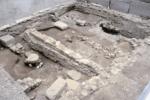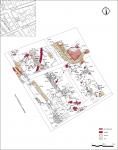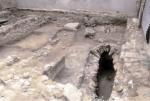Summary (English)
During this intervention, part of the initial stretch of a cardo minor, starting from the city wall, as well as its corresponding cloaca, was documented. The road has two superimposed layers of paving: the first is from the Late Imperial Roman period, consisting of a surface of crushed rock and mortar, and the second is from Late Antiquity, consisting of flattened gravel and soil. It appears that this road was never paved with diorite, although it may have been dismantled during the intervening period between the two road surfaces that were discovered. Beneath the first paving, along the longitudinal center of the street, we can find the cloaca dug into the rock. Unlike other sewage systems that have been documented in the city, this one lacks lateral walls, as the rock itself serves as one, basinging the masonry vault on a step recessed precisely for that function. To the north of the excavated zone, we can observe remodeling in the cloaca, to which a narrower canal has been added. This canal has been engineered in a different manner than the rest in that it uses an abundance of brick and mortar. It is most likely associated with the piping for part of the excess water from the Los Milagros aqueduct, with the purpose of sweeping away the detritus from the sewage system.
Two small canals, which probably originate from the adjoining house, flow into the cloaca and cross beneath the portico of the street. Another canal that was documented to the south also crosses the portico, carrying the water directly to the roadside ditch. We believe that this is a house, although the available components cannot confirm this hypothesis. More than half of the site is occupied by the road, which indicates that it could possibly be another urban structure.
The Roman structure was leveled almost completely to its foundation from Late Antiquity, constructing three living spaces that seem to be a house; however, it contains a very small space four rooms made of brick and tiles. The road was maintained, though it no longer had a portico and was repaved with gravel. The walls are made of reused materials (stone blocks, shafts, and other various elements) compacted with soil and the floors are made of orange-colored clay interspersed with layers of ash.
This building was not refurbished around the sixth century, rather several walls were knocked down to the rock, abandoning the zone. No further structures were found until modern times, when the recently- demolished house was constructed. There is only a pit with a robbed stone block and an Islamic silo, both of which were constructed in the tenth century.
In the center of the excavated area the existence of a pre-Roman silo has been confirmed. Only the base was preserved, as it seems that the area was leveled when the Roman city was founded. This structure is tied to others that have appeared in the area surrounding the Cerro del Calvario.
The site that served as the subject of our survey is situated in a highly protected zone. Thus, all of the remains were conserved and covered with a layer of washed sand measuring 4 cm thick. The rest of the space was subsequently backfilled with dirt up to contemporary ground level .
(translation by Emily Marie Polacek)
- Santiago Feijoo Martínez
Director
- Santiago Feijoo (Consorcio Ciudad Monumental de Mérida)
Team
- Mª Luisa García
- Francisco Isidoro, Alberto Crespo y Joaquín Suárez
- Javier Pacheco
- Javier Oliva, Andrés Escudero, Paco Llanos, Julián Benítez, Pedro Ruiz, Daniel Suárez
Research Body
- Consorcio Ciudad Monumental de Mérida






![Download [PDF]](/excavation/skins/fasti/images/results/download_sml.png)





